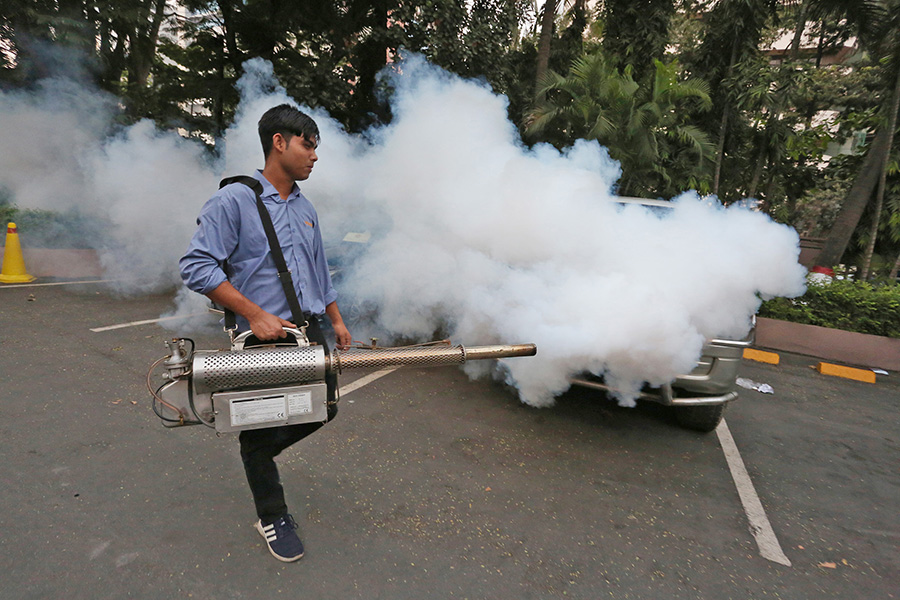
Published :
Updated :

It is a losing battle against dengue. If the year 2019 was the worst year in terms of dengue infection and death, this year's early signs are even more ominous. This is high summer, albeit interspersed with rains, and the number of hospitalisation of patients with dengue fever is going up every day. It looks like the prevalence of and fatality from the disease are higher this early compared to any year in the past.
Mostly an urban affliction, dengue stalks the length and breadth of the capital city throughout the year, although it starts peaking in late June and usually reaches the optimal point in August. It seems the higher it is the concentration of population in a mega city, the greater the chance of Aedes aegypti proliferating. Naturally Dhaka city leads the pack. Chattogram and Khulna come next on the list of dengue-inflicted cities in the country. Villages are mostly free from Aedes aegypti but home to Aedes albopictus. Urban centres are, however, not free from this less known variety of mosquitoes too.
The problem with dengue is that no vaccine is there for acquiring immunity against the vector mosquito bite. Also for many patients it is asymptomatic and by the time a patient comes to know about its infection, it is too late. Climatic factors like rise of temperature and rainfalls are directly responsible for higher incidence of dengue. This is so because, both higher temperature and rainfalls create a favourable condition for breeding the Aedes cousins which prefer laying eggs in empty containers where fresh water can accumulate.
Samir Shukla, in his article published in The Times of India presents an insightful picture so far as the breeding and getting the virus in the ovaries of female Aedes are concerned. Contrary to the popular perception, these mosquitoes stick their hardy eggs on the side of an empty container, not laying in fresh water, where they can lie dormant for months. When they come in contact with accumulated rain waters, the eggs turn into larvae and then into young mosquitoes.
In Gujrat, the observance of "Dry Day" when all containers are emptied did not prevent mosquito breeding. The measure, Shukla claims, is based 'on a half-truth'. Both dengue virus and its vectors have developed their own strategies to survive human intervention like the emptying of rejected or other containers where fresh water can accumulate. For Aedes, the strategy is brilliant. The mosquitoes get their eggs stuck on the side of a container and that too above the water level, knowing that water more often than not goes down. There the eggs can lie dormant for six to nine months in dry condition before they come in contact with freshly poured water to be activated.
Similarly, the viruses of dengue, chikumgunia, zika and other diseases have found a trick to use the mosquito eggs as a reservoir by entering those in order to stay safe for the lean period. Their collaborative venture turns out to be deadlier than it would have been otherwise. The vector in this case does not need to bite an already dengue-infected person before injecting a healthy person to give the disease. But from day one, a progeny of a once-infected Aedes mosquito will start infecting any people it bites. It does not have to go through the process of getting infected from the plasmodium of a dengue patient first and then infecting others.
Considering the ingenuity of both the vector and virus, therefore, the eradication of Aedes through conventional exercise such as emptying of containers and fogging of the breeding places and spots will be simply impossible. Since both mosquitoes and the virus have become smarter to adapt to human interference, there is indeed a need for reviewing the entire campaign against Aedes mosquitoes. The good thing is that the virus cannot infect a person on its own. So, if the fight can be effectively launched against the vector, there is a chance of winning against the tiny but deadly enemy.
In this regard, Samir Shukla's suggestion is worth following. He advises scrubbing the sides of containers very hard after those have been emptied. If there are residues, those should not be thrown away. Instead those should be collected to put on fire.
However, without the authorities becoming familiar with the campaign against Aedes in Gujrat and convinced of the merit of this fresh strategy, things cannot move ahead. The public awareness campaign against the mosquitoes will therefore need some additional do's and dont's. The mayor of Dhaka North City Corporation on return from his visit to the US made it amply clear that fogging is a futile exercise to eliminate mosquitoes and deactivate their breeding grounds. From his visit to America, he came across the scientific methods applied to eliminate mosquitoes. This is indeed the time for such a move before the endemic dengue turns into a pandemic.
By this time the official campaign headlines should include the additional measures so that people know why dengue poses to stage a comeback with a vengeance. If the eggs are destroyed before they have a chance to hatch, more than half of the battle is won.


 For all latest news, follow The Financial Express Google News channel.
For all latest news, follow The Financial Express Google News channel.